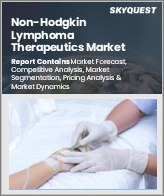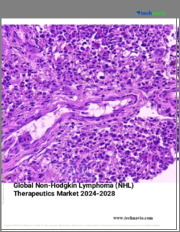
|
시장보고서
상품코드
1532665
비호지킨림프종 치료 시장 : 유형별, 성별 - 세계 예측(2024-2032년)Non-Hodgkin Lymphoma Therapeutics Market - By Type (B-cell [Diffuse Large, Follicular, Mantle Cell], T-cell [Peripheral, Cutaneous, Anaplastic Large Cell], Therapy Type (Chemotherapy, Radiation, Targeted Therapy)), Gender - Global Forecast (2024 - 2032) |
||||||
세계의 비호지킨림프종 치료 시장은 의약품 개발의 진전과 치료 옵션의 확대에 의해 2024-2032년 CAGR 7.4%를 기록합니다.
표적치료 및 병용요법과 같은 의약품의 혁신은 다양한 림프종 아형에 대한 관리 효과를 향상시킵니다. 이러한 발전은 미충족 의료 수요를 충족시키고 맞춤 치료 접근법을 제공합니다. 새로운 치료법이 개발되고 승인되면 환자와 의료 서비스 프로바이더의 선택의 폭이 넓어지고 시장 수요 증가와 효과적인 치료 옵션 확대에 기여합니다.
예를 들어 2023년 4월 FDA는 Polivy(R)(polatuzumab vedotin-piiq)와 Rituxan(R)(rituximab) 및 기타 약물의 병용요법을 승인하여 20년 만에 새로운 B세포 림프종 치료제로 승인했습니다. 이 병용요법은 병의 진행 위험을 27% 감소시킵니다. 이 새로운 치료법은 B세포 림프종 환자의 치료 옵션을 확대하고 질병 진행 위험을 현저하게 감소시킵니다. 이러한 새로운 치료법이 20년 만에 도입된 것은 시장의 혁신과 성장 잠재력을 강조합니다. 신약 개발에 대한 관심과 투자가 증가함에 따라 시장 역학에 영향을 미치고 치료 옵션이 확대될 가능성이 있습니다.
비호지킨림프종 치료 시장은 유형, 치료 유형, 성별, 지역별로 분류됩니다.
T세포 림프종 분야는 T세포 림프종의 복잡하고 다양한 아형에 대한 인식이 높아짐에 따라 2032년까지 주목할 만한 급격한 성장을 경험할 것입니다. 이 부문의 성장은 표적 치료에 대한 수요와 T세포 림프종의 특정 메커니즘에 대한 이해의 진전에 의해 주도될 것입니다. 지속적인 연구개발 노력은 보다 효과적이고 맞춤화된 치료법을 개발하여 T세포 림프종으로 인한 고유한 문제를 해결하고 환자 결과를 개선하기 위해 시장 확대의 원동력이 되고 있습니다.
화학요법 분야는 주요 치료법으로 자리 잡은 역할에 힘입어 2024-2032년 큰 폭의 성장을 보일 것으로 예상됩니다. 화학요법은 여전히 비호지킨림프종 관리의 핵심이며, 암세포를 효과적으로 표적화하여 파괴하는 역할을 합니다. 다양한 약물이 광범위하게 사용 가능하고 다양한 병기에서 효능이 입증된 것이 이 시장의 우위에 기여하고 있습니다. 현재 진행 중인 연구와 발전으로 화학요법 요법이 계속 강화되고 있는 가운데, 비호지킨림프종 치료에서 화학요법의 보급률과 중요성은 계속 중요할 것으로 보입니다.
아시아태평양의 비호지킨림프종 치료 산업은 빠르게 성장하는 헬스케어 인프라와 유병률 증가에 힘입어 2032년까지 연평균 성장률(CAGR)이 두드러질 것으로 예상됩니다. 이 지역에서는 첨단 치료법에 대한 접근성 확대와 종양학 연구에 대한 투자 증가가 이러한 성장에 기여하고 있습니다. 또한 진단율의 향상과 환자 수 증가는 시장 확대를 더욱 촉진하고 있습니다. 아시아태평양은 의료 발전과 암 치료 수요에 대한 노력으로 비호지킨림프종 치료 시장 예측에 크게 기여하고 있습니다.
목차
제1장 조사 방법과 조사 범위
제2장 개요
제3장 업계 인사이트
- 에코시스템 분석
- 업계에 대한 영향요인
- 촉진요인
- 비호지킨림프종 이환율의 증가
- 투자와 연구개발 활동의 확대
- 신약 및 치료법 승인
- 업계의 잠재적 리스크 & 과제
- 치료비 상승
- 엄격한 규제 요건
- 촉진요인
- 성장 가능성 분석
- 파이프라인 분석
- 규제 상황
- Porter의 산업 분석
- PESTEL 분석
제4장 경쟁 구도
- 서론
- 기업 매트릭스 분석
- 기업 점유율 분석
- 경쟁 포지셔닝 매트릭스
- 전략 대시보드
제5장 시장 추산·예측 : 유형별, 2021-2032년
- 주요 동향
- B세포 림프종
- 미만성대세포형 B세포 림프종(DLBCL)
- 여포성 림프종
- 맨틀 세포 림프종
- 기타 B세포 림프종
- T세포 림프종
- 말초성 T세포 림프종
- 피부 T세포 림프종
- 역형성 대세포 림프종
- 기타 T세포 림프종
제6장 시장 추산·예측 : 치료 유형별, 2021-2032년
- 주요 동향
- 화학요법
- 표적치료
- 방사선 요법
- 기타 치료 유형
제7장 시장 추산·예측 : 성별, 2021-2032년
- 주요 동향
- 남성
- 여성
제8장 시장 추산·예측 : 지역별, 2021-2032년
- 주요 동향
- 북미
- 미국
- 캐나다
- 유럽
- 독일
- 영국
- 프랑스
- 스페인
- 이탈리아
- 네덜란드
- 기타 유럽
- 아시아태평양
- 일본
- 중국
- 인도
- 호주
- 한국
- 기타 아시아태평양
- 라틴아메리카
- 브라질
- 멕시코
- 기타 라틴아메리카
- 중동 및 아프리카
- 사우디아라비아
- 남아프리카공화국
- 아랍에미리트
- 기타 중동 및 아프리카
제9장 기업 개요
- Astellas Pharma US, Inc.
- AstraZeneca PLC
- Bayer AG
- Bristol Myers Squibb Company
- Celgene Corporation
- Eli Lilly and Company
- GSK plc
- F. Hoffmann La-Roche Ltd.
- Janssen Pharmaceuticals Inc.
- Seagen Inc
- Takeda Pharmaceutical Company Ltd.
- Teva Pharmaceutical Industries Ltd.
Global Non-Hodgkin Lymphoma Therapeutics Market will record a 7.4% CAGR during 2024 and 2032 due to advancements in drug development and the expansion of treatment options. Innovations in pharmaceuticals, such as targeted therapies and combination treatments, enhance the effectiveness of managing various lymphoma subtypes. These advancements address unmet medical needs and offer personalized treatment approaches. As new therapies are developed and approved, they provide more choices for patients and healthcare providers, contributing to increased market demand and a broader range of effective treatment options.
For instance, in April 2023, the FDA approved Polivy(R) (polatuzumab vedotin-piiq) combined with Rituxan(R) (rituximab) and other drugs, marking the first new B-cell lymphoma treatment in 20 years. This combo reduces disease progression risk by 27%. This new treatment offers a notable reduction in disease progression risk, enhancing therapeutic options for B-cell lymphoma patients. The introduction of such a novel therapy after 20 years underscores the market's potential for innovation and growth. It may drive increased interest and investment in the development of new therapies, influencing market dynamics and expanding treatment choices.
The non-Hodgkin lymphoma therapeutics market is classified based on type, therapy type, gender, and region.
The T-cell lymphomas segment will experience a noteworthy surge by 2032, attributed to the increasing recognition of T-cell lymphomas' complex and diverse subtypes. This segment's growth is driven by the demand for targeted therapies and advancements in understanding the specific mechanisms of T-cell lymphomas. Ongoing research and development efforts are leading to the creation of more effective and personalized treatments, addressing the unique challenges posed by T-cell lymphomas and enhancing patient outcomes, thus driving market expansion.
The chemotherapy segment will witness a substantial uptick between 2024 and 2032, propelled by its established role as a primary treatment method. Chemotherapy remains a cornerstone in managing non-Hodgkin lymphoma, effectively targeting and destroying cancer cells. Its wide range of available drugs and proven efficacy in various stages of the disease contribute to its dominant market position. As ongoing research and advancements continue to enhance chemotherapy regimens, its prevalence and importance in non-Hodgkin lymphoma treatment remain crucial.
Asia Pacific non-Hodgkin lymphoma therapeutics industry will uphold a notable CAGR through 2032, spurred by its rapidly growing healthcare infrastructure and increasing disease prevalence. The region's expanding access to advanced treatments and rising investments in oncology research contribute to this growth. In addition, improving diagnosis rates and a significant patient population further drive market expansion. Asia Pacific's advancements in healthcare and commitment to addressing cancer care needs position it as a primary contributor to the non-Hodgkin lymphoma therapeutics market forecasts.
Table of Contents
Chapter 1 Methodology & Scope
- 1.1 Market scope & definitions
- 1.2 Research design
- 1.2.1 Research approach
- 1.2.2 Data collection methods
- 1.3 Base estimates & calculations
- 1.3.1 Base year calculation
- 1.3.2 Key trends for market estimation
- 1.4 Forecast model
- 1.5 Primary research and validation
- 1.5.1 Primary sources
- 1.5.2 Data mining sources
Chapter 2 Executive Summary
- 2.1 Industry 360°synopsis
Chapter 3 Industry Insights
- 3.1 Industry ecosystem analysis
- 3.2 Industry impact forces
- 3.2.1 Growth drivers
- 3.2.1.1 Increasing incidence of Non-Hodgkin lymphoma
- 3.2.1.2 Expanding investment and R&D activities
- 3.2.1.3 Approval of new drugs and therapies
- 3.2.2 Industry pitfalls & challenges
- 3.2.2.1 High cost of treatment
- 3.2.2.2 Stringent regulatory requirements
- 3.2.1 Growth drivers
- 3.3 Growth potential analysis
- 3.4 Pipeline analysis
- 3.5 Regulatory landscape
- 3.6 Porter's analysis
- 3.7 PESTEL analysis
Chapter 4 Competitive Landscape, 2023
- 4.1 Introduction
- 4.2 Company matrix analysis
- 4.3 Company market share analysis
- 4.4 Competitive positioning matrix
- 4.5 Strategy dashboard
Chapter 5 Market Estimates and Forecast, By Type, 2021 - 2032 ($ Mn)
- 5.1 Key trends
- 5.2 B-cell lymphomas
- 5.2.1 Diffuse large B-cell lymphoma (DLBCL)
- 5.2.2 Follicular lymphoma
- 5.2.3 Mantle cell lymphoma
- 5.2.4 Other B-cell lymphomas
- 5.3 T-cell lymphoma
- 5.3.1 Peripheral T-cell lymphoma
- 5.3.2 Cutaneous T-cell lymphoma
- 5.3.3 Anaplastic large cell lymphoma
- 5.3.4 Other T-cell lymphomas
Chapter 6 Market Estimates and Forecast, By Therapy Type, 2021 - 2032 ($ Mn)
- 6.1 Key trends
- 6.2 Chemotherapy
- 6.3 Targeted therapy
- 6.4 Radiation therapy
- 6.5 Other therapy types
Chapter 7 Market Estimates and Forecast, By Gender, 2021 - 2032 ($ Mn)
- 7.1 Key trends
- 7.2 Male
- 7.3 Female
Chapter 8 Market Estimates and Forecast, By Region, 2021 - 2032 ($ Mn)
- 8.1 Key trends
- 8.2 North America
- 8.2.1 U.S.
- 8.2.2 Canada
- 8.3 Europe
- 8.3.1 Germany
- 8.3.2 UK
- 8.3.3 France
- 8.3.4 Spain
- 8.3.5 Italy
- 8.3.6 Netherlands
- 8.3.7 Rest of Europe
- 8.4 Asia Pacific
- 8.4.1 Japan
- 8.4.2 China
- 8.4.3 India
- 8.4.4 Australia
- 8.4.5 South Korea
- 8.4.6 Rest of Asia Pacific
- 8.5 Latin America
- 8.5.1 Brazil
- 8.5.2 Mexico
- 8.5.3 Rest of Latin America
- 8.6 Middle East and Africa
- 8.6.1 Saudi Arabia
- 8.6.2 South Africa
- 8.6.3 UAE
- 8.6.4 Rest of Middle East and Africa
Chapter 9 Company Profiles
- 9.1 Astellas Pharma US, Inc.
- 9.2 AstraZeneca PLC
- 9.3 Bayer AG
- 9.4 Bristol Myers Squibb Company
- 9.5 Celgene Corporation
- 9.6 Eli Lilly and Company
- 9.7 GSK plc
- 9.8 F. Hoffmann La-Roche Ltd.
- 9.9 Janssen Pharmaceuticals Inc.
- 9.10 Seagen Inc
- 9.11 Takeda Pharmaceutical Company Ltd.
- 9.12 Teva Pharmaceutical Industries Ltd.



















